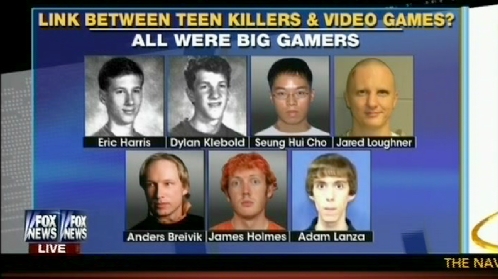In an effort to sidetrack the debate in the wake of the Washington Navy Yard shooting away from strengthening gun laws, Fox News has repeatedly suggested that violent video games are the root cause of such atrocities.
To bolster this argument the network has often featured a graphic claiming that numerous recent mass shooters were “big gamers.”
It's a characterization that suggests that before they murdered innocents, the killers spent their time playing the sort of violent, first-person shooters that have been criticized by some for their depictions of gory murder with firearms.
Academic researchers have failed to find a link between playing video games and acting out real world violence. Other nations with similar rates of video game spending fall far short of the United States in gun-related murders. And even the goriest of first-person shooters sell tens of millions of copies without creating tens of millions of murderers.
But even the media's anecdotal attempt to connect such games with mass shootings falters given that they are falsely characterizing the reported gaming history of the killers, several of which favored strategy or role-playing games, not first-person shooters.

The Fox image reinforces a media narrative that has been in place since the massacre at Columbine High School in 1999. After the shooting that killed 13 and injured 24others, it was revealed that the shooters Eric Harris and Dylan Klebold were fans of video games like Doom.
Doom is a “first person shooter,” in which the player, who looks down the barrel of a gun from the perspective of the game's lead character, kills demons and other undead monsters.
Academic researchers have failed to find a link between playing these violent games and acting out real world violence. But since Columbine the media has often latched on to any and all reporting that connects video games to mass shooters and often tried to equate it to the same type of games the Columbine shooters played.
Here are the gaming backgrounds of the other shooters featured in Fox's graphic, which often are at odds with the impression given by looping them all together as “big gamers”:
Seung Hui Cho, the Virginia Tech killer who gunned down and killed 32 people and injured 17 in 2007, was widely described as an avid gamer in reports right after the massacre. But subsequent reporting has cast doubt on this depiction.
NBC News reported that a paragraph describing Cho as a fan of Counter-Strike, a first person shooter, was removed “without explanation” from a Washington Post story a short time after it was posted soon after the attack. After Cho's dorm room was searched, no video games or gaming consoles were listed on the search warrant.
In a 2007 report commissioned by then-Governor Tim Kaine to investigate the shooting, a detailed study of Cho's mental health was released. The report found that as a child, Cho played games without “violent themes” like Sonic The Hedgehog, a nonviolent cartoonish game about a wisecracking hedgehog that collects gold rings.
The report went on to note that Cho's junior year roommate at Virginia Tech “never saw him play video games,” while his senior year roommate “never saw him play a video game, which he thought strange since he and most other students play them.”
Jared Loughner, who killed 6 people and injured 14 others (including Rep. Gabrielle Giffords) in a 2011 shooting in Arizona, reportedly played games like Starcraft, Diablo, and Earth Empires. None of those games are first person shooters.
The Starcraft series are top-down strategy games, in which players harvest resources, build military structures, command military units, and ultimately attempt to attack the base of their opponent.
Earth Empires is a similar sort of game, but is completely text-based. The Diablo series, are top-down games as well, in which the player wields a sword and other medieval weapons along with magical spells to fight demons.
Anders Breivik, who shot and killed 77 people in Norway in 2011, claimed that he used the game Call of Duty: Modern Warfare to train himself for his attack. Modern Warfare is a violent first person shooting game that has sold more than 10 million copies.
Further, Breivik's mental state when making these claims about the video game (he claimed that a holographic targeting system used in the game could turn a grandmother into “a super marksman”) should be taken into consideration. Breivik described his attack as a “sharp signal to the people” warning them about encroaching “cultural Marxism” and an Islamic takeover of Europe.
James Holmes killed 12 and injured 70 at a movie theater in Aurora, CO, in 2012. The police inventory of Holmes' apartment listed the video games Skyrim, StarCraft, and Oblivion.
Both Skyrim and Oblivion are installments in The Elder Scrolls series of games, which are set in a fantasy world of swords, magic, and medieval combat. The action in these games is sometimes depicted in a first person perspective, but the protagonist generally wields a sword or bow and arrow -- not a gun.
Adam Lanza killed 27 and injured 2 in Sandy Hook, CT, in 2012. Reporting on Lanza connects his gaming experience to the previously mentioned Call of Duty series.
Simply listing these killers as “big gamers” when the actual games they played (or didn't) are so different in tone, content, and intensity is irresponsible, even ignoring the lack of evidence demonstrating anything but the most remote connection between simulated video game violence and real world murder.
What almost all of the shooters had in common, however, was access to guns and thus the ability to take multiple lives within minutes.